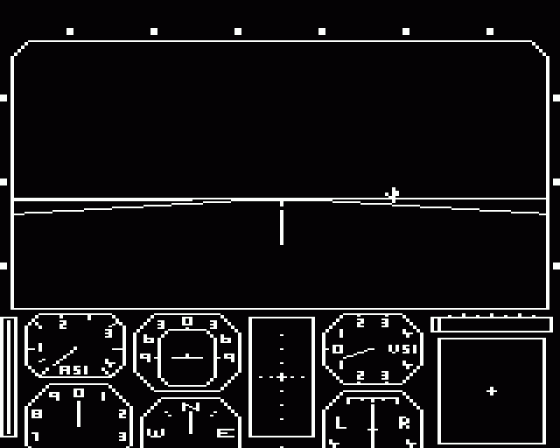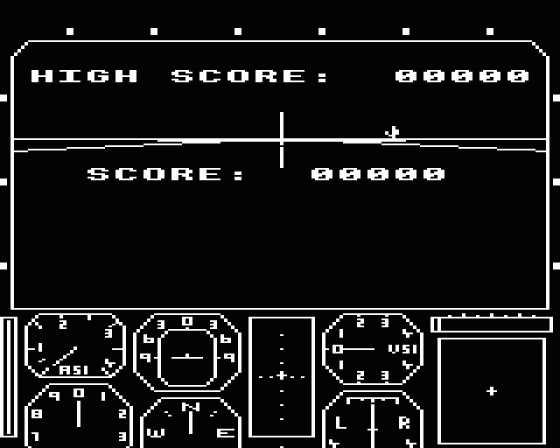Aviator
There's a fair number of flight simulators around now for the BBC and other smallish micros - and for the most part they'd have trouble simulating Grandma making a cup of tea. Let's face it, a straight line and a rectangle with dots on it isn't exactly state of the art. The outlook was pretty bleak until Acornsoft entered the scene and with characteristic Battle of Britain panache dumped Aviator in our laps.
It's quite something. First time up I was airsick. Then I crashed a lot, which is to be expected. It takes a couple of years to get the hang of walking, so flying is bound to turn up the odd problem here and there, but then that's half the fun.
The 'plane in question is a Spitfire Mk II, in full detail. Anything a real Spitfire can do so can Aviator. Barrel rolls, looping, hedge-hopping... the works. Try raising the undercarriage before taking off and the landscape lurches dramatically as the dead ship flops its belly onto the ground.

It's all in pseudo-vector graphics (that's like drawings to you and me), but the competition pales in comparison. The difference between Aviator and the rest is the landscape - fields and trees, a river with a bridge under it and even a town called - what else - Acornsville. Points are awarded for flying under the bridge or through Acornsville. Double points if you're crazy enough to try it upside-down.
There there's The Theme, a touch of real class. Aliens (?) shaped like door wedges sit in the fields hoovering up the harvest and bolting back half a field or so they grow wings and head for Acornsville where they make a start on the local population.
In the early stages the trick is to hedge-hop until you get fairly close and then lean on the fire button and plant a burst of cannon fire between their teeth. They kick up a fair amount of turbulence, though, so don't get too close.

After a bit, the fuel starts to run low, but that's no problem. Just set down on the runway and nip off for a bite of breakfast while the Spitfire refuels. Once you get the hang of it you could probably keep going for a week.
This is an exceptional piece of work; nothing that I've seen for the BBC comes anywhere near it. It's a little pricier than the rest of the Acornsoft games - but don't be put off; you'll probably get more out of it than any other game you buy.
Yes, But Is It A Hun Killer?
The Spitfire Mk II on which the Acornsoft Aviator game is based was by and large the machine actually in service at the time of the Battle of Britain. It differed from the earlier Mk I in having a three-bladed propeller and, as a result, slightly enhanced speed. Its armament - here the Acornsoft version does not correspond to the original - was the famous set of eight .303 Brownings (not two wing-mounted cannons - these only came in with the 1941 Mk V).

In reproducing the flying characteristics of the Spit Acorn have gone further down the reality road than any other flight sim known to Big K - with the honourable exception of Microsoft's Flight Simulator for the IBM PC and clones. In order to keep the memory reserves high and avoid the problem of high-speed continuous fills (as the horizon tilts, so does a new solid map need to be filled), they have stuck to one colour and ignored solids altogether. This reduces the horizon problem to single line proportions.
The best thing about Aviator is the instrumentation. None of your crummy digital readouts, but proper dials that can be read at a glance. Everything has been thought of - failure to raise the undercart will hold the speed and the nose down and make the machine pitch uncontrollably. Takeoff speed seems a little high, and I'm not sure whether a fully-fuelled Spit unsticks quicker than an empty one (as it should and did).
Top speed in level flight of the original was around 323mph - in a dive it was anybody's guess up to and exceeding 450. So it is here (nearly), with the entirely realistic provision that if you pull out too rapidly your wings fall off. The same dangers lie in wait for all overenthusiastic aerobats.
At the end of the day, flight simulations are just that: simulators. At least half the dangerous manoeuvres your eye alone can warn you of in Aviator would - in the real thing - be detected and avoided by the famous "seat of the pants" feeling - i.e. if your stomach doesn't like it, then neither will the airframe. But until Acorn or some other entrepreneurs (probably Torch) conceive a way of putting you and your Beeb in a stilt-mounted, hydraulically operated, oil-smelling, exceedingly noisy box (with eight .303 Brownings) this will probably remain the state of the art.
Other Reviews Of Aviator For The BBC Model B
Aviator
Flight Of Fancy
Aviator (Acornsoft)
Off Into The Wide Blue Yonder
Aviator (Acornsoft)
A review
Aviator (Acornsoft)
A review
Aviator (Acornsoft)
A review by Mike Williams (Beebug)
Aviator (Acornsoft)
Really Flying


 3rd August 1984
3rd August 1984


